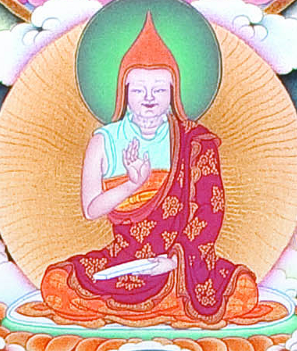Dharmakirti of Suvarnadvipa: Difference between revisions
Jump to navigation
Jump to search
(Tibetan.) |
No edit summary |
||
| (3 intermediate revisions by 3 users not shown) | |||
| Line 1: | Line 1: | ||
[[File:Serlingpa.png|frame|Dharmakirti of Suvarnadvipa]] | [[File:Serlingpa.png|frame|Dharmakirti of Suvarnadvipa]] | ||
'''Dharmakirti''' (Skt. ''Suvarṇadvīpa Dharmakīrti'' | '''Dharmakirti''' (Skt. ''Suvarṇadvīpa Dharmakīrti''; Tib. ཆོས་ཀྱི་གྲགས་པ་, ''Chökyi Drakpa'', [[Wyl.]] ''chos kyi grags pa'') or '''Dharmapala''' (Wyl. ''chos skyong'') of [[Suvarnadvipa]] (b. 10th century) was the most important of [[Atisha]]'s teachers. In Tibetan he is known simply as '''Serlingpa''' (Tib. གསེར་གླིང་པ་, Wyl. ''gser gling pa''), literally 'the master from Suvarnadvipa'. [[Atisha]] is said to have stayed with him for twelve years receiving teachings on [[Lojong]]. | ||
==Writings== | ==Writings== | ||
Latest revision as of 17:26, 14 September 2018

Dharmakirti (Skt. Suvarṇadvīpa Dharmakīrti; Tib. ཆོས་ཀྱི་གྲགས་པ་, Chökyi Drakpa, Wyl. chos kyi grags pa) or Dharmapala (Wyl. chos skyong) of Suvarnadvipa (b. 10th century) was the most important of Atisha's teachers. In Tibetan he is known simply as Serlingpa (Tib. གསེར་གླིང་པ་, Wyl. gser gling pa), literally 'the master from Suvarnadvipa'. Atisha is said to have stayed with him for twelve years receiving teachings on Lojong.
Writings
He wrote two texts on the Bodhicharyavatara summarizing its main points.
Further Reading
- David Seyfort Ruegg, The Literature of the Madhyamaka School of Philosophy in India, Wiesbaden: Harrassowitz, 1981, pp. 109-110